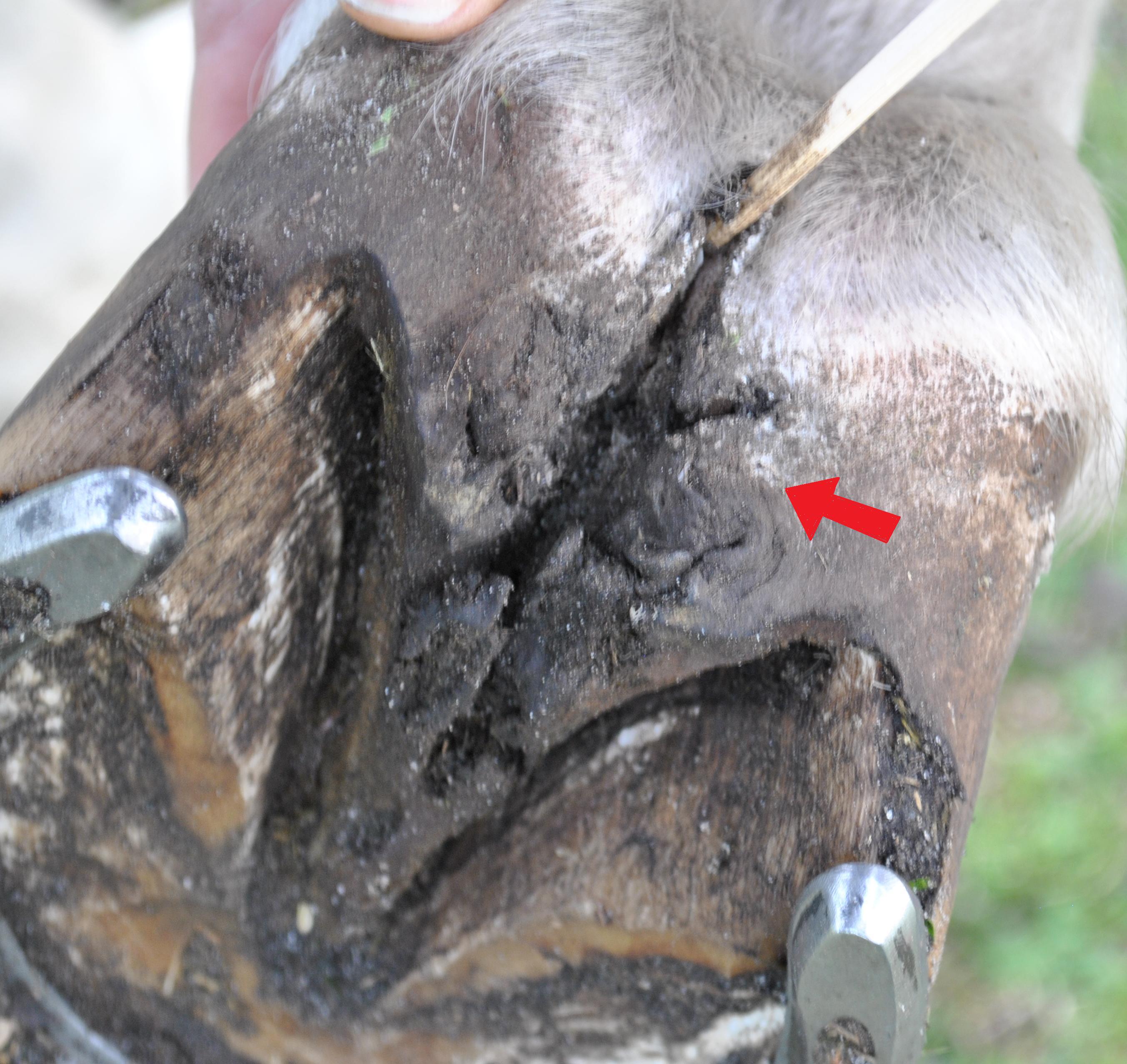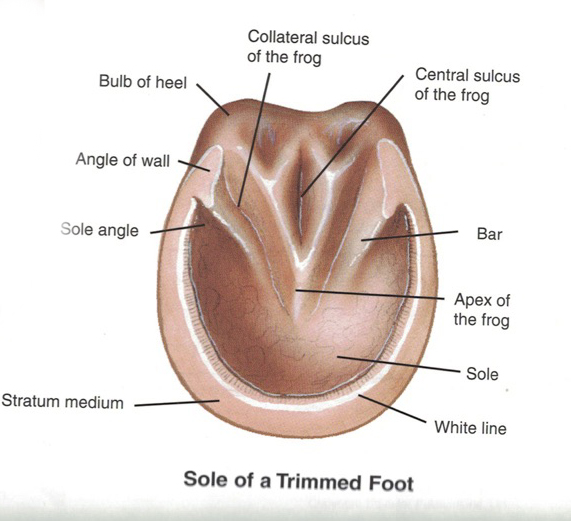Thrush is the horseman’s term for infiltration of the horse’s sole and frog tissue by bacteria and fungi that are present in the his everyday environment. The presence of thrush in a horse’s foot represents a management issue. If thrush is present, it is readily apparent by inspection of the bottom of the horse’s foot.

As an Amazon Associate, Dressage Today may earn an affiliate commission when you buy through links on our site. Products links are selected by Dressage Today editors.
Typically, thrush is characterized by a foul, rotten odor from the bottom of the foot, along with dark brown to black discoloration and moist softening of the frog and horn tissue generally centered around the sulci of the frog and along the white line.
To really understand thrush, a short review of the anatomy of the solar surface of the equine foot and some physics is in order. You can skip this section if this sort of detail bores you, but I like to break things down into their smallest bits. This helps you think through and develop prevention and treatment strategies that are more applicable to individual situations.

The solar surface of the horse’s foot, from the center to the perimeter, consists of the central sulcus of the frog, which is a narrow groove of variable depth that starts between the heel bulbs and runs toward the apex (point) of the frog (see illustration). Moving outward from there is the frog itself. On each side of the triangular-shaped frog are the collateral sulci. These are grooves of variable depth that separate the sole and heel quarters from the frog. The collateral sulci are deeper toward the heel bulbs and become shallower toward the point (apex) of the frog. Moving farther outward toward the toe of the foot is the sole. Toward the heel is the heel quarter and heel buttress. The perimeter of the foot is bounded by the hoof capsule. The hoof capsule and sole are joined at the white line, which is the actual junction of the sole and hoof wall at solar surface of the foot. The sole and frog tissue is made of keratinized or cornified skin tissue (epidermis), which, like the human nail is not sensitive or living, but is produced by living tissue deeper in the foot and functions as a protective barrier to keep this deeper tissue safe from the environment.
Now for the physics: The average horse used for dressage weighs between 1,000 and 1,250 pounds. This weight is supported by the four feet, each of which is roughly 6 inches in diameter. Although horse feet are not really circular, their shape is roughly circular, so a good estimate of the area of the bottom of the average dressage horse’s foot is approximately 28 square inches. Approximately 60 percent of the horse’s weight is borne by the front feet, thus 40 percent by the hind feet. The pressure under the front feet of the horse is roughly 14 pounds per square inch. The pressure under the hind feet is roughly 10 pounds per square inch. This is if the horse is bearing weight equally at all times, which we know is not the case, so these figures are the minimum pressure exerted upon the ground by the foot. This degree of pressure is enough to prevent air and light from entering the space under the foot when the horse is standing. A horse’s foot is slightly concave, or cup-shaped, so that more weight is borne at the perimeter, along the walls.
When the horse bears weight, material under the foot is largely trapped by this concave shape. Any material that is under the foot that comes under this pressure will be forced upward into the sulci of the frog and the cracks and crevices of the sole of the foot. In a stall or in the paddock, the material under the foot is generally a mixture of bedding, dirt, manure and urine.
Dressage horses, in particular, may spend more time in their stalls than horses of other disciplines and may therefore have more manure and urine underfoot at any one time than other horses. The bottom line is that the dark, high-pressure, anaerobic (without oxygen) environment is perfect for producing bacterial and fungal invasion of the frog and solar tissue.
A regular and frequent cleaning regimen of the horse’s stall and environment, as well as the feet themselves, is key to preventing thrush. A hoof pick is necessary, but a key tool in preventing thrush is a sturdy wire brush, the kind that is sold in hardware stores, the kind favored by painters or welders. The wire scratch is used to remove sole and frog horn and debris after the hoof pick is used and more thoroughly cleans the bottom of the foot than just the hoof pick or a softer brush. Daily use of antiseptic medications that are formulated to kill fungi and bacteria in the foot is also key to preventing the development of thrush.
It has been observed that thrush is more common in the hind feet. There may be a few factors contributing to this. The most important is that horses eliminate (manure and urine) from the back end and the hind feet are more likely to be standing in this material than are the front feet, particularly in a stall situation.
Thrush is generally confined to the nonliving or insensitive parts of the foot. Therefore, there is generally no pain or inflammation associated with the condition, and there is generally no reason to change a horse’s exercise regimen because he has thrush in one or more feet. However, if not noticed and not treated or managed, the bacteria and fungi can extend through the horny tissue into the deeper, sensitive area of the foot, leading to infection, pain and lameness. This infection can even extend deeper into the limb, resulting in serious cellulitis.
Treatment of thrush is based on a few key efforts. First is to understand and correct the particular environmental conditions that have led to the development of thrush. These may be a combination of stall-cleaning regimens, the horse’s elimination habits, bedding choices and even hoof conformation. For instance, a horse with deep frog sulci who drinks a lot and therefore urinates a lot and gets little turnout is a candidate for the development of thrush.
Second, the infested frog and sole tissue should be carefully and judiciously pared and scraped away. This reduces the volume of diseased tissue and numbers of bacteria and fungi. If the thrush is deep, this is something you may want your farrier or veterinarian to do.
Lastly, the sole, frog and frog sulci should be treated with hoof antiseptics regularly to dry the tissue and environment and kill bacteria and fungi that cause thrush. These antiseptics are usually liquids that contain strong iodine, formaldehyde or mineral salts (copper sulfate most commonly). They are usually squirted or sprayed onto the cleaned sole of the foot every day to every other day. For more serious cases of thrush, there are also products that are soaks, containing chlorine, that are useful to treating thrush. The chlorine in the soaking solution turns to chlorine gas that infiltrates deep into the cracks and crevices of the foot and results in more disinfection than material applied to the surface.
In summary, thrush is a hoof hygiene issue that can be prevented with regular environmental and hoof maintenance. Treatment centers on removal of environmental conditions contributing to it and providing medications that kill bacteria and fungi and foster a healthy, cleaner environment under the foot.
Greg Staller, DVM, received his doctor of veterinary medicine degree from the University of California at Davis in 1987. With primary interests in surgery, lameness diagnosis and treatment, ultrasonography, ophthalmology and internal medicine, he is a Diplomate of the American College of Veterinary Surgeons and is on the board of directors of the Northeastern Association of Equine Practitioners. Married to FEI dressage rider Catherine Haddad, he is the founder and owner of Running ‘S’ Equine in Califon, New Jersey, and provides sports-medicine services in Wellington, Florida, and Aiken, South Carolina, during the winter season.











